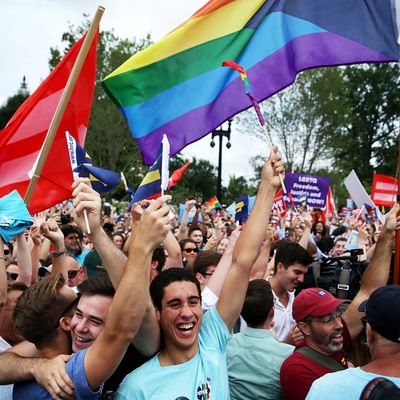
The Supreme Court’s decision affirming marriage equality hastens what was already a fait accompli — public opinion has embraced the equal right to marriage at such a rapid clip that it was bound to spread to the deepest red precincts of America within a generation or two. The decision is also the latest signpost of an important structural change that will define the current era in American life. The United States is undergoing a period of social transformation as profound and rapid as any it has seen since the 1960s. The revolution — it may not be too strong a term — has been driven by elected officials and judges, and from the broader culture, the three strands all reinforcing one another.
In 2004, George W. Bush used his opposition to same-sex marriage as a cudgel that helped enable him to win the decisive electoral votes in Ohio. In 2008, when Barack Obama ran for president, he found it necessary to disavow support for marriage equality. By 2012 he was able to make his support public. In 2016, it is unlikely that even the Republican candidate will openly oppose it, perhaps retreating to the defense of the odd florist or baker to refuse to sell flowers or cake to a same-sex couple. That the conservative stance on same-sex marriage has settled on a handful of oddball characters reveals how the majority position has been reduced to the counterculture fringe.
This transmutation was very much on the mind of Antonin Scalia, whose dissent conveys an anger far broader than a single decision, even as momentous as this is, could bear. Scalia has registered his dissent not from a single judicial conclusion but from an entire historical epoch. His dissent rages at the unrepresentative, coastal character of the Court (“a select, patrician, highly unrepresentative panel of nine”), imposing its values upon large segments of helpless, unrepresented flyover country. It is notable that Scalia’s dissenting argument contains the seeds of its own intellectual capitulation by embracing the logic of affirmative action. Indeed, Scalia takes the logic farther than all but the most extreme affirmative-action advocates themselves would. He insists not only that more socially diverse bodies carry advantages, but that decisions by socially unrepresentative bodies are completely illegitimate (“no social transformation without representation,” in his remarkably broad formulation.) Scalia likewise scoffs at the premise that access to marriage amounts to freedom at all, snarking, “Ask the nearest hippie.”
The hippie is a symbol of the 1960s, and one of the few remaining safe targets for reactionary angst against that era. And the 1960s offer the best available parallel to the changes sweeping through American culture and politics. That period saw an intense expansion of activist government in the economic sphere, just as the current one has (Obamacare; stronger regulation of Wall Street and greenhouse-gas emissions). Then, as now, judges created new rights, legislatures created others, and new attitudes spread organically through the culture.
A great deal has happened in a very short time. America elected its first black president, and is likely to follow that by electing its first female one. Obama appointed two women to the Supreme Court, including the first Latina justice, ended the ban on openly gay military service, and carefully nudged along the groundswell of support for marriage equality. This opened space for government and businesses to recognize transgender rights, and for transgender icons like Laverne Cox and Caitlyn Jenner to emerge. Feminist reforms in the home and workplace, driven by figures like Sheryl Sandberg and Tina Fey, have gained renewed momentum. Youth culture has anathematized bullying, which was once considered a normal and inevitable rite of childhood, and created a pride of place for nerd culture. Social autonomy has sprung forward on almost every front.
These changes have gained impetus from smartphones and social media, which have hastened a broad sense of social self-representation. Cities across America, working with the Department of Justice, have begun undertaking police reforms, all driven by the near-universal access to handheld video recording, which has subjected officers to a once-unimaginable accountability. There is an illiberal edge lurking along the margins of all these changes as well: Political correctness is what happens when the left can dominate a subculture to the point of rendering any disagreement impossible. But the overall thrust of the transformation is to expand rather than to contract individual autonomy and self-expression.
And where old horrors recur, they are greeted in new ways. A few years ago, North Charleston police officer Michael Slager would be a local hero who fired his weapon in self-defense. Now he faces prosecution for cold-blooded murder in front of the whole country. A half-century ago, racist murderers like Dylann Roof operated with broad social sanction, or even with the cooperation of the law. Crimes such as his may continue, but they exist in a completely different social context.
The recent, rapid reconsideration of Confederate symbolism in a sense epitomizes all this. Its direct impact is small, but it stands for something vast: a country reconsidering its entire historical arc, tearing down old myths inflected with white-supremacist propaganda and placing the fight for social equality at the center of its self-conception. Periods of historical momentum such as the current one do not last forever; they breed backlash. But the progress they usher very well can last forever. The United States will never go back to the days when a person born gay could not hope to enjoy marriage. It will never go back to thinking of a president who is not white and male as abnormal. The country as it existed as recently as a decade ago is receding permanently into the mists of time.
*A version of this article appears in the June 29, 2015 issue of New York Magazine.






























